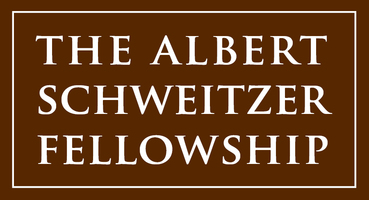By Cary Estes, UAB Medicine Magazine —
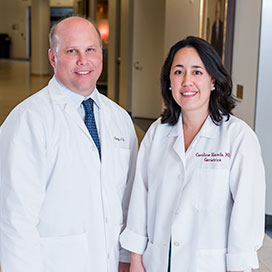
Medical students’ days are a constant rush of workshops, lectures, and textbooks, and their evenings are spent deciphering the meaning of seven-syllable words and memorizing that the hand bone is connected to the distal phalange bone. But there is another part of being a physician that can fade from view as students tackle the monumental learning challenges of medical school; the part that is described in the Hippocratic Oath as the “art of medicine,” where “warmth, sympathy, and understanding may outweigh the surgeon’s knife or the chemist’s drug.” The part that can be referred to simply as service.
In recent years, the School of Medicine has worked to better integrate these two aspects of being a physician into the school’s curriculum. Students still must accumulate an enormous amount of “book learning,” but they also need to learn how important compassion is to the practice of medicine, and the ways that health care (and lack thereof) affects people’s lives in the world outside the lecture hall. In other words, they need to combine both service and learning.
“The problem during the first two years of medical school for many students is that there is very little context for the millions of facts they are learning,” says Caroline N. Harada, M.D., assistant dean for community engaged scholarship in the School of Medicine. “But if you have an actual patient telling you about the pain they’re having in their feet, all of a sudden neuropathy becomes real to you. You can more easily remember everything you’ve learned, because you have a real patient with a real story to attach it to. And students start to think about the science of medicine in the context of real societal issues such as poverty and diversity.”
In an effort to fully leverage the benefits of service learning, the School of Medicine created the Office of Service Learning (OSL) in 2015. The goal is to formalize service learning as part of the official medical school curriculum. “The idea is, if you can adapt the curriculum so students have opportunities to go out and do work that’s needed in the community, all while enriching and enhancing the lessons that take place in the classroom, it impacts students in a way that’s far more powerful than a lecture or group discussion alone,” says Harada, who oversees the OSL. “We saw a real opportunity to take the students’ pre-existing passion for service, and allow them to apply lessons that are being taught in the classroom while also helping others.”
Student-Inspired Service
It hasn’t always been this way, of course. For decades, the path to becoming a physician basically began and ended in the confines of the medical school, with a few detours in between. Students soaked up all the knowledge they possibly could, passed their exams, and went out into the world to start practicing medicine. That template began to change around the beginning of the 21st century.
“There’s been an evolution of service as a way to meet educational objectives,” says Craig J. Hoesley, M.D., senior associate dean for medical education. “We see it in the accreditation standards. The Liaison Committee for Medical Education is the accrediting body for U.S. medical schools, and their standards have evolved over the last 10 to 15 years. They have increasingly asked about service learning: Is it required? What kind of activities do you sponsor?
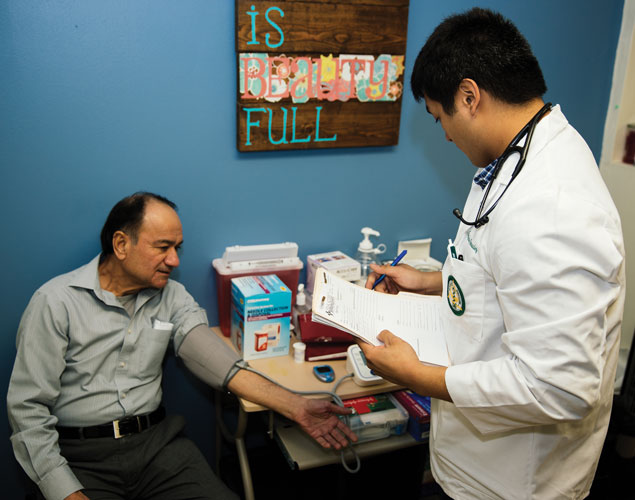
Medical student Timothy Fernandez works with a patient at the student-run free clinic, Equal Access Birmingham. “We’re fortunate in that service learning has been emphasized here even before the standards evolved, beginning with our admissions process,” Hoesley continues. “When we’re looking at prospective students, we ask, how is this person engaged in their community? We certainly want the academics, the GPA, but the community element is important as well. A drive for service is emphasized during the admissions process, and while they’re here in school we don’t want them to lose sight of that.”
Hoesley says it was medical students themselves who lit the spark that led to the school’s first organized foray into service learning. About 10 years ago, a group of third-year students approached Hoesley about starting a community clinic to provide free medical care to vulnerable and underserved populations in Birmingham. They wrote funding grants, raised donations for medications and equipment, and eventually partnered with the M-POWER Health Center in Avondale. The Equal Access Birmingham (EAB) Clinic at M-POWER was open every Wednesday night and, with faculty oversight, students examined anybody who walked through the door.
The clinic later moved to the Church of the Reconciler closer to the UAB campus and is now open to chronic care patients every Sunday afternoon. A new acute care clinic takes place Wednesday afternoons, and a mental health clinic is open one Saturday a month. EAB students also participate in traveling clinics where they go to a community center or church and conduct basic exams such as blood pressure screening and provide diabetes management counseling. More than 150 medical students and 30 physician volunteers took part in the EAB clinics between 2014 and 2015.
“EAB has really taken off and become a staple for our students,” Hoesley says. “We follow more than 200 patients continuously, and anybody who comes through the door is also welcome. It’s a way for students to hone clinical skills and meet educational objectives, and it also engages them in the community and better prepares them for practice.
“Managing patients who are under-resourced is incredibly challenging,” Hoesley continues. “How do you help somebody who has no resources? These students are learning how to do it by helping these patients. That’s incredibly valuable to the community and will make our students better practitioners.”
Fostering Solutions
With the creation of the Office of Service Learning, the School of Medicine is incorporating these types of service-learning techniques into the curriculum under the auspices of the school’s Learning Communities initiative. Each incoming student is assigned to a Learning Community, a faculty-mentored, small group of about 18 students from all four classes that serves as an emotional and educational home base for students throughout their medical school years.
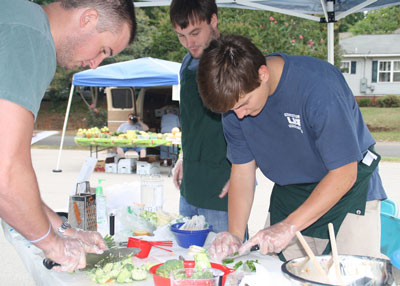
Medical students demonstrate cooking with affordable and healthy recipes at the East Lake Farmers Market.“In the past, we’ve had students work as docents at McWane Science Center, do neighborhood cleanup in Woodlawn, work in clinics for the uninsured doing health screenings, a variety of things” Harada says. “Last year, each Learning Community was invited to submit a proposal for a new project that the Office of Service Learning would roll out the following year. So they went from being the student to being the teacher.”
The top four proposals were presented to the entire school in a Service Learning Competition last spring. Four expert panelists questioned each group about their proposal, and the student body voted on the winner. The project being implemented this fall is called “Cooking Healthy on a Budget,” in which students research recipes for healthy and affordable meals and demonstrate the recipes and healthy cooking techniques at the East Lake Farmers Market.
“Nutrition is an area that is under-taught in medical schools,” Harada says. “This is an opportunity for us to engage in more in-depth teaching about nutrition, while also improving the students’ understanding about social determinants when it comes to eating and food choices. They will be challenged to find recipes where all the ingredients are available with food stamps, and to keep the cost under a certain amount so families can actually afford it.
“Projects like this make the medical-school experience feel real. It’s a way for students to stay true to the reasons that they went into medicine in the first place.”
Committed to Community
Service is at the core of the Albert Schweitzer Fellowship (ASF), which was founded in 1940 to support Schweitzer’s charity hospital in Gabon, Africa. Today, the ASF is dedicated to improving the health of vulnerable populations at home and abroad by developing a corps of professionals skilled in creating positive change in their local communities, within the broader health and human service systems, and throughout the world. Each year, approximately 250 graduate students in a variety of fields are selected as Albert Schweitzer Fellows. Each fellow partners with a community-based organization to develop and conduct a yearlong service project. Last year, UAB launched the organization’s 13th U.S.-based chapter, housed at the School of Medicine. This spring, six School of Medicine students were named to the inaugural class of Alabama Schweitzer Fellows.
“The mission is about preparing the next generation of professionals who will serve and empower vulnerable people to live healthier lives and create healthier communities,” says Kristin Boggs, director of the Alabama chapter of the ASF. “Schweitzer Fellowship projects are unique in several respects. First, it’s a yearlong experience where they must commit to at least 200 hours of service to plan and execute their project. Secondly, our goal is that the projects be sustained beyond their year of service by the community organization where it was implemented, a student group, or another Fellow.”
“We expect fellows to define for themselves what type of change they want to see in the participants and the community at large. What defines success? This isn’t meant to be a research project, but it is data collection in the sense of making sure they’re having the intended impact that best serves the community.”
Taylor Baskin, a second-year medical student from Birmingham, says she has a strong interest in helping people with autism. To that end, she has created a program to work with adults and children at the Glenwood Autism and Behavioral Health Center to improve their health and self-esteem through dance and exercise.
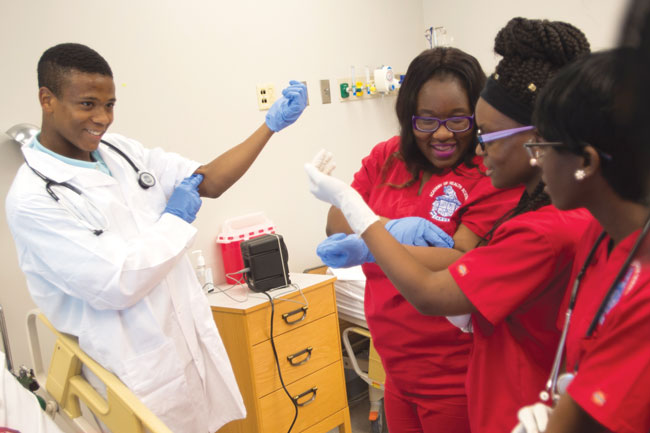
David Osula, a second-year medical student from Jasper, agrees. He is working with Carver High School’s Academy of Health Sciences on a mentoring program for students who are interested in careers in health care. Birmingham City Schools sponsor Academies of Health Sciences at three Birmingham high schools to prepare students for health professions training after high school.
“We want to empower them to learn more about their career interests and pursue those interests—shepherd them through the process and just be friends and role models,” Osula says. “This type of service learning allows you to engage the community around you, and encourages you to reflect and really try to learn from the hands-on experiences you’re having. I think it’s a great addition to the curriculum.”
Another Schweitzer Fellow, fifth-year M.D./Ph.D. student Shima Dowla of Lexington, Ky., is furthering an interest she developed as an AmeriCorps volunteer, when she worked to integrate homeless patients into the health care system. Now she is developing and implementing a healthy living program for low-income adults with diabetes and obesity who receive care at the EAB Clinic.
“The fellowship allows me to use the skills I’ve learned to create a program for a community that I am deeply committed to—that’s what is exciting to me,” Dowla says. “The book learning is important, but we really only learn about the disease. With this, we’re not just treating the disease, we’re treating the person. And treating the person requires a lot more than what we learn in the classroom.”
That is what service learning is all about—students applying classroom lessons to a cause they are passionate about to improve the world around them. “About 85 percent of our graduates are from Alabama, and a significant portion of them will practice here, so this can only help communities in our state,” Hoesley says. “I think it’s an obligation that we, as the state’s top medical school, have to produce not only competent physicians, but also ones who feel an obligation to benefit their communities in a meaningful way.”
